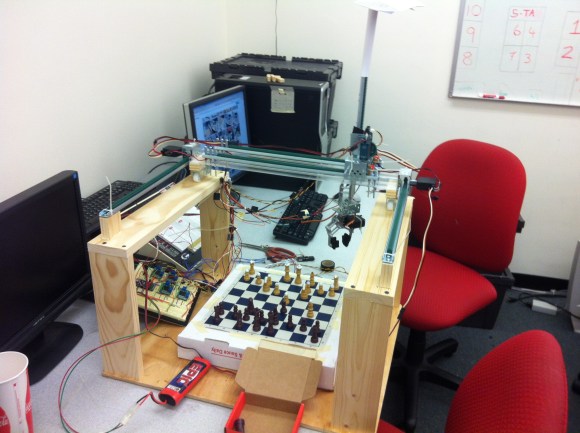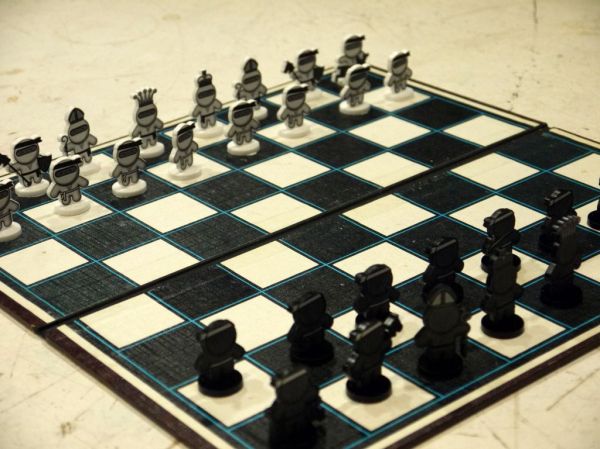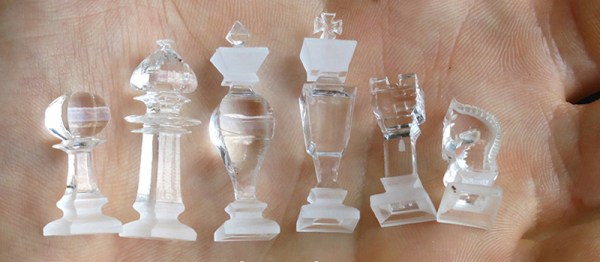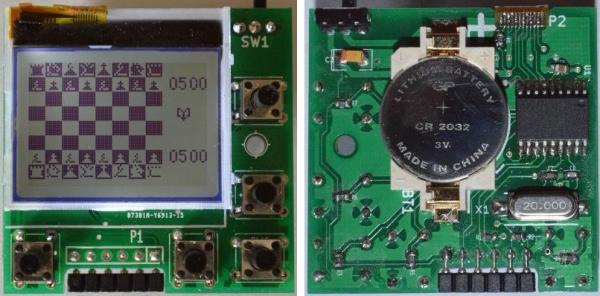A lot of computers can play chess. [Matthew Lui’s] Giraffe is a chess playing computer, but unlike other common chess programs, Giraffe taught itself to play. It apparently learned pretty well, too, since it is rated as an International Master on the FIDE scale (putting it in the top 2.2% of players. The top chess playing computers clock in at super grandmaster level but they are not self-taught).
chess54 Articles
Make Your Own Ninja Chess Board
You’re going to want to take a look at this fun project [Alistair MacDonald] just finished up. He calls it Ninja Chess.
He’s had the idea to 3D print a complete set of ninjas vs pirates for a chess board, but, let’s be real; printing thirty-two chess pieces would take a long time. He opted to use a laser cutter instead, and so far, only has the Ninja characters drawn. But it still makes for a pretty awesome chess board.

He drew the characters in Inkscape and they’re pretty darn cute. He has all the files available over on his Instructable including the .DXF for the laser cut outlines, and the image files for you to print off the decals. But unless you’re good with scissors, we recommend using your hackerspace’s automated paper cutter to help speed things up.
Is it a hack? Not really, but it’d be an excellent addition to anyone’s workshop. And while we sail under the Jolly Wrencher, we too can appreciate the novelty of a Ninja chess board.
For a more detailed build, did you see the 3D laser cut chess pieces we shared a few weeks ago? No that’s not a typo — you can use a laser cutter to do more than just two-dimensional cutting…
3D Miniature Chess Pieces Made With A Laser Cutter
When you think of laser cutters, you generally don’t think of 3d parts. Well, at least not without using something like glue, nuts and bolts, or tabs and slots to hold multiple parts together. [Steve Kranz] shows you how to make these very tiny 3D chess pieces by making 2 passes at right angles to thick acrylic. The first pass cuts one side’s profile, then the part is rotated 90 degrees and a second pass is cut, giving the part more of a “real” 3D look, rather than something cut out of a flat sheet. If you’re having a hard time imagining how it works, his pictures do a great job of explaining the process. He even added some engraving to give the chess pieces for a selective frosted look. We think it’s a cool idea, and well executed too!
But that got us to thinking (always dangerous) that we’ve seen rotary attachments for laser cutters, but they are mainly for etching cylindrical objects like champagne flutes and beer bottle. What if you added a rotating “3rd” axis to a laser cutter that could hold a block of material and rotate it while being cut? (Much like a traditional 4th Axis on a CNC machine). Would the material also need to be raised and lowered to keep the laser focused? Surely software that is aimed at 3D CNC would be needed, something like Mach3 perhaps. A quick Google search show that there are some industrial machines that more-or-less do 3D laser cutting, but if you, or someone you know of, has attached a 3rd axis to a desktop laser, let us know in the comments, we would love to see it.
(via Adafruit)
Lonely? Build Yourself A Chess Robot!
[Oriol Galceran] has constructed an interesting robotic chess player for his end of school project. It’s called the ChessM8, and is an impressive feat considering [Oriol] is only 17! He’s using an Arduino Mega that connects to the host PC via a Python script.
The AI can be any chess engine that uses the Universal Chess Interface protocol, which [Oriol] points out that most of them do. We’ve seen other chess robots here before, along with others that you can play on your wall and uses Nixie Tubes. But [Oriol’s] build is the largest of them all.
He says there’s a network of REED switches under the chess board to detect when a piece is present or not. It would be interesting to know how he dealt with debouncing issues, and if Hall Effect sensors might have been a better choice. Let us know in the comments how you would detect the chess piece.
And be sure to check out the video below to see the chess robot in action.
Tiny Chess Playing Computer
We have covered many chess computers in the past, but we think this might just be the smallest. Enter the PIC Blitz: A tiny low-cost low-power computer that can play lightning chess.
It’s based on a PIC16F628A microcontroller, which only has 3.5kbytes of flash and a mere 224 bytes of RAM. For comparison, Boris (one of the first consumer chess computers), utilized an 8-bit microprocessor with 2.5 kbytes of ROM and 256 bytes of RAM.
PIC Blitz has a full fledged chess library: it knows all the moves, all the basic openings and even changes its evaluation function weights as the game progresses to keep the game interesting. The creator [Mark Owen] quips about some of the additional techniques he utilized to make up for the limited processing power; including “pondering time”, a difficult and slow user interface, and of course, a barely-comprehensible LCD.
If you’re interested he has released the files under Creative Commons, and has a link to the PCB layout on the project page – we won’t link it directly though, since it goes straight to a download.
[Thanks Martin!]
Hackaday Links: Sunday, May 19th, 2013
![]()
Laser cutter owners may find this online box design tool which [Jon] built quite useful. It’s got a few more joint options than the Inkscape box design add-on does.
Apparently the US Navy has the ability to bring down drones in a flaming pile of laser-caused death. [Thanks Joshua]
[Michail] has been working on a transistor-based full adder. He’s posted a Spice simulation if you want to learn about the design.
Turn your crystal clear LED bodies into diffuse ones using a wooden dowel, power drill, and sandpaper. The results look better than what we’ve accomplished by hand. [Thanks Vinnie]
Play your favorite Atari Jaguar games on an FPGA thanks to the work [Gregory Estrade] did to get it running on a Stratix-II board. You can pick up the VHDL and support tools in his repo. If you’re just curious you can watch his demo vid.
Members of Open Space Aarhus — a hackerspace in Risskov, Denmark — have been playing around with a bunch of old server fans. They made a skirtless hovercraft by taping them together and letting them rip. Too bad it can’t carry its own power supply
Here’s another final project from that bountiful Cornell embedded systems class. This team of students made a maze game that forms the maze by capturing walls drawn on a white board.
And finally, here’s a unique chess board you can build by raiding your parts bin. [Tetris Monkey] made the board from the LCD screen of a broken monitor. The playing pieces are salvaged electronics (like big capacitors) against corroded hardware (like nuts and bolts). We think it came out just great!
Voice Controlled Chess Robot

[Ben Yeh] wrote in to tell us about this voice-controlled chess robot he built along with three others as a final project for their Georgia Tech ECE 4180 Embedded Systems Design class.
To handle the speech recognition they grabbed an EasyVR board. This is a fine solution because it prevents the need for a computer to process voice commands (remember, it’s an embedded systems class). This concept breaks down when you find out that the desktop computer next to the robot is where the chess game is running. Perhaps that can be moved to a microcontroller by the next set of 4180 students.
The robot arm portion of the project is shown off well in the clip after the break. Normally we’d expect to see stepper motors driving the axes of a CNC machine but in this case they’re using servo motors with built-in encoders. The encoders are i2c devices which feed info back to the main controller. There was a parts ordering snafu and the z axis motor doesn’t have an encoder. No problem, they just added a distance sensor and a reflector to measure the up and down movement of the claw.















